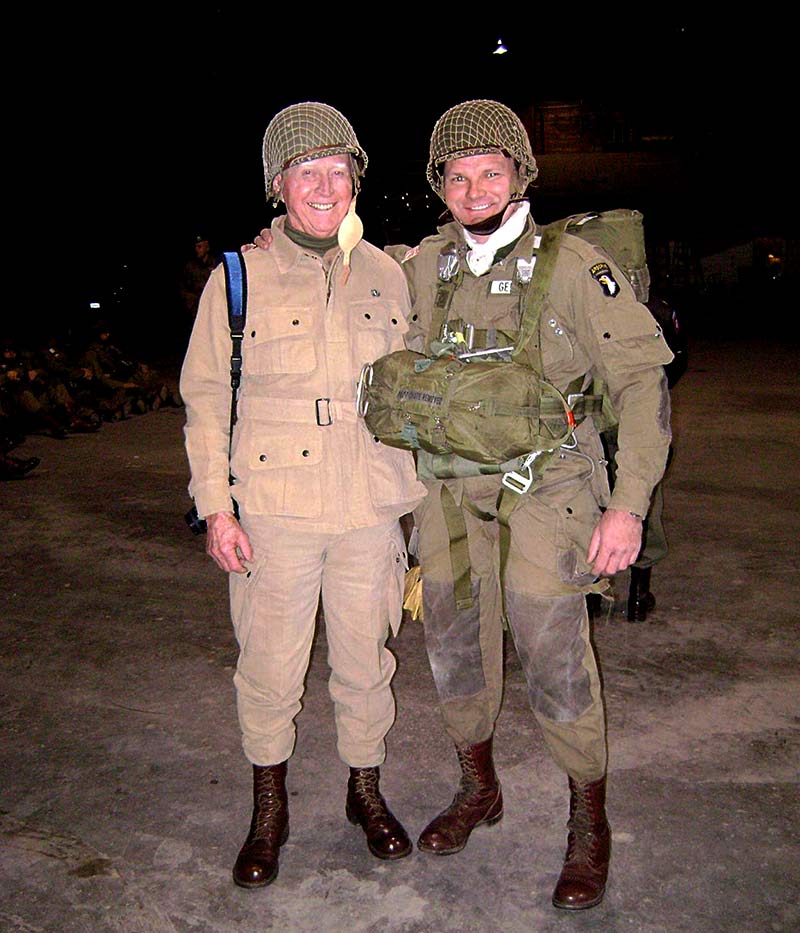United Pilot Jumps with Vintage Airborne Unit to Mark History
In the early morning hours of June 6, 1944, some 13,000 paratroopers of the U.S. 82nd and 101st Airborne Divisions leapt into the sky above Normandy, France, as part of the initial wave of the World War II D-Day invasion. Popular novels and movies like Band of Brothers and The Longest Day recall this historic event; but for hardcore enthusiasts like F/O Martin Gerhard (United), nothing beats the exhilaration of actually jumping out of a restored 1942 C-47 together with dozens of fellow living historian paratroopers.
A B-777 pilot based in Chicago, Ill., Gerhard is a member of the WW II Airborne Demonstration Team, part of a foundation that honors the brave veterans of this era—some of whom are still with us—and educates the public about this important period in history with drop demonstrations. The airborne unit is located at the former WW II Army Air Corps Training Base at Frederick Municipal Airport in Frederick, Okla.

F/O Gerhard (right) with Gene Gilbraith, a veteran from the WW II 101st Airborne Division.
“We travel around the United States to do airshows and reunions with vets who made the actual jumps,” says Gerhard, who notes that the group has performed throughout North America and Europe. In 2009, the airborne unit traveled to Holland for the 65th anniversary of WW II’s Operation Market Garden (think A Bridge Too Far), the largest airborne drop of its time. “And, of course, we plan to be there in 2014 for the 70th anniversary of the Normandy invasion,” Gerhard says.
Like many males of his era, Gerhard grew up with a fascination for WW II history, particularly the D-Day invasion. He’s made extensive visits to the Cherbourg peninsula in France where the campaign was fought. Gerhard has also served as a volunteer for the Arizona wing of the Commemorative Air Force (CAF), a nonprofit organization dedicated to preserving and displaying historic military airplanes at airshows. A friend at the CAF referred him to the WW II–period unit in Oklahoma. He signed up in January 2008, survived the training, and has been a part of the team ever since. Decked out in a period M-42 jumpsuit, helmet, parachutes, and boots, Gerhard notes, “It’s an amazing experience.”
Training for the airborne unit is a grueling 10-day event that includes a series of tests to ensure that candidates are able to grasp the techniques and procedures necessary to make a successful static-line jump. “The training days are hot, long, and exhausting, and you will be tired and sore from performing hundreds of PFLs [parachute landing falls], drag training, and emergency procedures,” says Gerhard, “but the reward of jumping out of a C-47 in honor of our veterans is priceless. To shake their hands before exiting the aircraft at 1,500 feet AGL is truly a once-in-a-lifetime experience.”
Gerhard earned his gold jump wings and had the privilege of getting them pinned on by a WW II paratrooper during a formal ceremony.
He has also had the opportunity to fly Boogie Baby, the outfit’s C-47. “It’s a handful,” he says. “Other than flaps and gear, there’s no hydraulics assist on the controls. It’s all cables, and you definitely have to have solid stick-and-rudder skills.” Gerhard got checked out on the tail-dragger in 2010 and says, “It’s a really basic aircraft—all dials and levers and two big, round engines that are sensitive and finicky.” He notes that the airplane is challenging to land, particularly in a strong crosswind.
Gerhard is not the only ALPA pilot in this airborne unit. He has jumped with Capt Dave Brothers (United), with whom he has also flown a trip. F/O Rodney Roycroft (Delta), another fellow paratrooper, serves as a head jumpmaster for the group. Together, these pilots share a bond and mutual admiration for a special breed of veterans who fought against the Axis powers of the 1940s to defend the world from tyranny.

